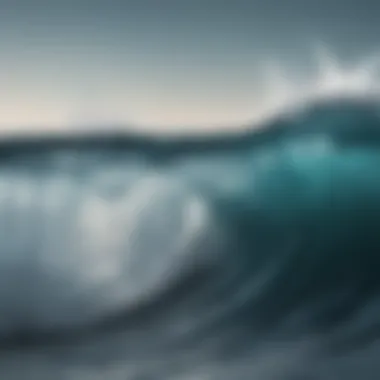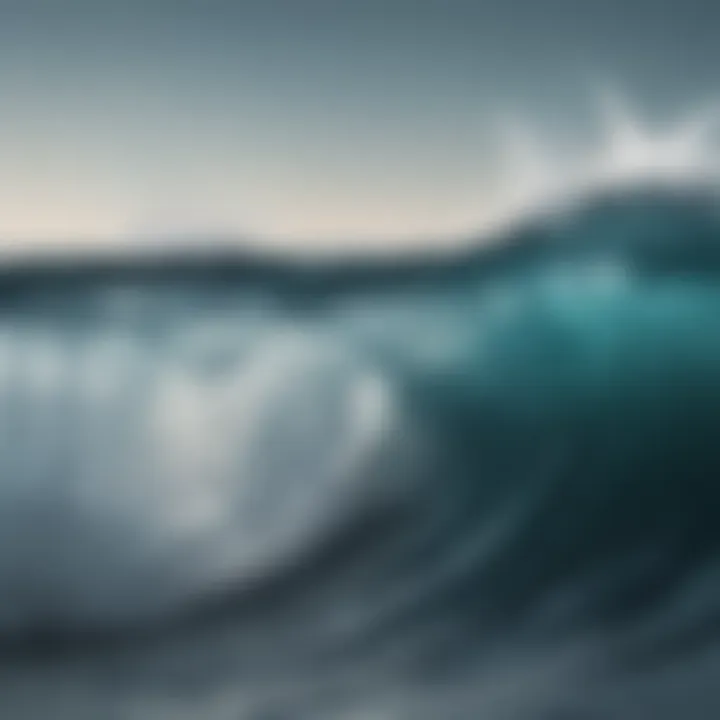Examining Ocean Salinity: Natural and Human Factors


Intro
Understanding ocean salinity is like peeling an onion — every layer you uncover reveals more complexities beneath the surface. The saltiness of the ocean is not just a simple measurement; it's a vital sign of the health of marine environments and impacts everything from tides to weather patterns. Salinity isn't uniform either. It varies from one region to another, influenced by a cocktail of natural phenomena and human activity. In this article, we shall explore the myriad sources and implications of ocean salinity, giving both adventurers and scholars valuable tools to appreciate our vast oceans better.
The story of ocean salinity begins with its genesis — how minerals from land and atmosphere make their way into saltwater. As we journey deeper, we’ll discover the role that evaporation and freshwater influx play in shaping salinity levels. Furthermore, as we examine the feedback loops between salinity and marine life, the importance of these variations will crystalize, providing insights that are crucial for both recreational water enthusiasts and those dedicated to ocean studies.
This piece not only serves as a reference for watersport lovers but aims at enlightening instructors and gear reviewers on the profound science that supports their passions. So, whether you're riding the waves or studying their mysteries, let’s dive into the salty depths of oceans and uncover how these elements blend together to create the buoyant world we explore.
Understanding Ocean Salinity
Understanding ocean salinity is foundational for making sense of the ocean's behavior and its interactions with climate systems and marine ecosystems. Salinity, or the concentration of salt in seawater, is influenced by various natural and anthropogenic processes, each contributing uniquely to the oceanic environment. For enthusiasts and professionals alike—surfers, paddleboarders, kitesurfers, and gear reviewers—having a grasp on salinity not only informs one’s understanding of ocean conditions but also enriches the appreciation of aquatic adventures.
The concept of salinity is not just a number; it plays a critical role in determining water density, which in turn affects ocean currents, weather patterns, and, ultimately, our global climate. Moreover, fluctuating salinity levels can significantly influence where different marine life thrives, impacting biodiversity and the health of our oceans.
Defining Salinity
Salinity refers specifically to the amount of dissolved salts in water, measured in parts per thousand (ppt). When we think about seawater, it isn't just NaCl; it encompasses a cocktail of various salts including magnesium, calcium, and potassium, alongside trace elements. The average salinity of ocean water is around 35 ppt, but this is not uniform across the globe. In fact, salinity levels can vary significantly between different bodies of water and even within the same body due to factors such as evaporation, precipitation, and freshwater influx.
To put it simply, salinity is defined as the total concentration of all ions in the seabed. This can affect everything from the buoyancy of objects in water to the way species adapt to their environments.
The Importance of Salinity in Ocean Dynamics
Salinity plays a vital role in the complex dynamics of our oceans. Here are some points to consider:
- Density Stratification: Salinity, combined with temperature, influences water density, consequently impacting stratification in ocean layers. This stratification is crucial for nutrient mixing, which supports marine food webs.
- Current Patterns: Different salinity levels contribute to variations in ocean currents. These currents transport heat and nutrients around the planet, impacting weather and climate.
- Ecosystem Services: Changes in salinity can shift habitats for marine species, affecting their reproduction and survival. In particular, adapting to sudden changes in salinity can be a major challenge for aquatic life, hence biodiversity is threatened when salinity varies too widely.
Overall, understanding salinity is not mere academic curiosity; it is essential for analyzing and predicting environmental changes in our oceans. As climate change accelerates, the implications of these salinity variations may have profound consequences that will need to be addressed with urgency.
Natural Sources of Ocean Salinity
Salinity in the oceans isn't just a random occurrence; it has roots deeply embedded in various natural processes. Understanding these natural sources is key to recognizing how our oceans maintain their distinctive saline characteristics. These sources play significant roles, not only in shaping the chemical make-up of seawater but also influencing marine ecosystems and overall oceanic health.
Mineral Leaching from Rocks
Chemical Weathering Processes
When rain pours down on exposed rock, it ain't just a water dance. Chemical weathering kicks off, breaking down minerals and sending nutrients and salts into rivers, eventually making their way to the ocean. This process significantly contributes to the salinity of oceans. The distinctive feature of chemical weathering is its ability to dissolve certain minerals this results in essential ions being transported.
This is an important aspect of salinity since it means that even the most remote rock formations can influence marine chemistry. However, one disadvantage is that not all minerals are leached evenly, creating disparities in salinity levels across different ocean regions.
Role of River Systems
Rivers are nature's arteries, carrying not just water but also a cocktail of dissolved minerals and salts. This phenomenon is crucial when we consider how freshwater systems impact ocean salinity. Rivers, flowing from varied terrains, pick up different minerals along the way. They act as a channel through which salts like sodium and chloride are transported into the oceans.
The unique feature of this process is how it continually refreshes ocean salinity; it’s a sort of cycle that allows for an even distribution of salts over vast areas. On the flip side, sometimes river systems can dilute the salinity in estuarine zones, leading to a less saline and more brackish environment.
Volcanic Activity
Underwater Volcanoes
When it comes to volcanism, feelings run deep under the sea. Underwater volcanoes are not just dramatic event makers; they are also significant sources of minerals. They release heated seawater that contains various dissolved minerals, including sulfur and chloride. The benefit of this process is that it adds unique geochemical elements to the seawater.
However, eruptions can change local salinity abruptly, creating inconsistent salinity levels that can impact marine life. These disruptions can either be temporary or long-lasting, depending on the intensity and frequency of volcanic activity.
Impact on Ocean Chemistry
The way volcanic eruptions affect ocean chemistry is like tossing a stone into a pond—ripples begin to spread. The gases and minerals released during eruptions can alter the pH level of surrounding waters, which in turn influences the behavior of salinity. This creates a dynamic environment where some areas may experience spikes in salinity due to volcanic emissions.
While this can add new life to otherwise stable ecosystems, it can also create challenges for marine organisms that are sensitive to rapid changes in water chemistry.
Atmospheric Contribution
Aerosols and Sea Spray
The atmosphere plays a surprising role in ocean salinity. The aerosols—tiny particles in the air—attach to ocean surface droplets, which can eventually be deposited back into the water, adding salty components. Sea spray, a byproduct of wave action, also contributes to this. The primary advantage of this process is the constant replenishment of salts into the ocean surface layer, making it a critical component in maintaining overall salinity levels.


Despite these advantages, the unpredictability of wind patterns and storm activity makes it challenging to quantify this contribution accurately, leading to variances in salinity across different ocean regions.
Precipitation Patterns
Rain might dilute the ocean, but its patterns can also contribute to salinity in different ways. In regions where heavy rainfall is frequent, the influx of freshwater can lead to lower salinity levels. Conversely, in arid regions, limited rainfall and high evaporation rates can concentrate salts further, raising salinity levels. This dual impact makes rainfall a pivotal player in the salinity game.
The geographical characteristic of precipitation patterns—whether they bring more rain or drought—can create significant salinity gradients. This is crucial in understanding how different ecosystems adapt to varying salinities, ultimately impacting the entire marine food web.
Salinity is not static; it fluctuates and adapts, constantly under the influence of natural processes and human activity. Understanding its sources lays the foundation for effective marine conservation efforts.
The Role of Evaporation
Evaporation plays a critical role in the ocean's salinity levels. This process not only contributes to the overall salinity but also influences the distribution and concentration of salts in different regions of the ocean. The dance between evaporation and saline water is so intertwined that comprehensively understanding it sheds light on the larger picture of ocean dynamics.
Process of Evaporation
Evaporation is basically the transition of water from its liquid state to vapor. This happens predominantly when the sun heats the surface of the ocean, making water molecules gain energy. You might say that these molecules "catch a ride" into the atmosphere. Interestingly, the molecules that escape are mostly pure water, leaving behind a concentration of salts. This is why, on sunny days, the salinity can appear higher—because as water evaporates, the remaining water holds more salt.
In terms of scale, think of the ocean as a huge pot on a slow boil. The heat from the sun causes water to evaporate continuously, but with each steam of vapor soaring off into the sky, left behind is a thicker broth of salt. What’s more, the rate of evaporation can significantly vary based on a few factors: temperature, wind speed, and humidity. For instance, at higher temperatures, more water molecules get that burst of energy required to break free into vapor, while windy conditions can enhance the evaporation rate by removing humid air from the surface more quickly. Thus, the geographical location of oceans plays a pivotal role in determining salinity levels through evaporation.
Concentration of Salinity
The concentration of salinity in ocean water is closely tied to the process of evaporation. As water evaporates, one can think of it as a salty cocktail being prepared. Picture a glass of ocean water where, as you slowly evaporate the liquid, the remaining concoction becomes saltier over time. This emphasis on concentration becomes particularly apparent in tropical regions, where high temperatures lead to elevated evaporation rates. Salinity peaks can reach astonishing levels in places like the Red Sea, demonstrating how environmental conditions directly correlate with salinity.
Moreover, areas that experience high rates of evaporation, such as subtropical latitudes, often observe significant salinity disparities compared to cooler regions. These variations influence not just the physical chemistry of the water, but also the marine life that depends on certain salinity levels for thriving. The vibrant ecosystems in these waters often adapt to these specific conditions, showcasing a compelling relationship between evaporation and biological diversity.
"Salinity isn’t just a number; it’s a crucial metric that helps define the boundaries of life in marine environments."
Ultimately, grasping the role of evaporation gives us insight into the dynamic nature of our oceans. This knowledge is indispensable, especially for watersport enthusiasts, who must navigate these varied salinity levels. Understanding how evaporation affects the water you paddle or surf can make all the difference in appreciating the intricate balance of life within the saline depths.
Freshwater Input: A Counterbalance
Freshwater input plays a crucial role in the salinity balance of oceans. It's like a breath of fresh air in the salty sea; it tempers the concentration of salts and minerals, allowing marine life to flourish. Without this counterbalance, the oceans would be much saltier, leading to extreme conditions that many organisms couldn't withstand. Understanding how freshwater influx interacts with higher salinity levels helps us grasp the complexities of ocean ecosystems.
Rivers and Streams
Impact on Local Salinity
Rivers and streams can significantly dilute ocean salinity, particularly in estuarine regions where freshwater meets saltwater. The melting of snow and the rainfall leads rivers to swell, becoming conduits of freshwater that ultimately flow into the sea. This natural process leads to local variability in salinity. For instance, the mixing of the Mississippi River’s freshwater with the saltier waters of the Gulf of Mexico creates a unique environment where diverse marine habitats thrive.
The key characteristic of this impact is its ability to create gradient zones. Such zones foster a variety of species, enabling both freshwater and marine organisms to cohabit. However, during periods of low flow, the salinity can rise quickly, posing challenges to organisms that rely on stable conditions. This dual nature is an advantage for freshwater input; it's a lifeline for biodiversity in transitional zones.
Seasonal Variations
Seasonal changes also greatly influence freshwater contributions to ocean salinity. In spring, melting snow and increased rainfall transform rivers into robust influxes of freshwater, while summer can bring drought, leading to decreased flow. This seasonal ebb and flow is pivotal for understanding changes in regional salinity.
The notable feature of seasonal variations is their predictability. Surfers and paddleboarders should take notice, as the salinity impacts water temperature and salinity stratification. High salinity often raises surface temperatures, potentially affecting wind patterns that influence waves. Conversely, a freshwater influx can lead to cooler surface waters, affecting the surf conditions. This knowledge is a boon for anyone keen on navigating oceanic waters.
Glaciers and Icebergs
Meltwater Contribution
The meltwater from glaciers and icebergs serves as another important freshwater source in the ocean. As temperatures rise, glacial ice retreats, releasing freshwater into the marine environment. This contribution is significant, especially in polar regions, where the water can buffer against local salinity increases.
A standout feature of meltwater is its clean nature. It often carries fewer salts compared to riverine inputs, providing a stark contrast to the existing saltwater. However, if large volumes are introduced quickly due to rapid glacial melting, it can destabilize local ecosystems and lead to stratification that might disadvantage certain marine species. The careful balance here is vital in comprehending oceanic health over time.
Geographical Influences
Geographical factors dictate how much glacial melt influences regional salinity. In areas where ice sheets exist, the rate of melting can vary dramatically based on ambient temperatures and ocean currents. For example, the Greenland ice sheet feeds into the North Atlantic, transforming salinity patterns crucial to global currents.
The key characteristic here is the location-specific nature of these influences. Regions closer to melting ice may experience sudden shifts in salinity and temperature, which can disrupt established marine communities. Such changes make understanding these geographical influences essential for ocean management and conservation efforts.
Rain and Snow Melt
Regional Variance


Regions around the globe see different amounts of rainfall, leading to distinct salinity profiles. Areas with heavy rainfall, like coastal regions in the tropics, can experience lower salinity levels, while arid zones with less precipitation lead to more saline oceans.
The primary concern about regional variance lies in its impact on local marine life. In estuarine areas, where rivers deposit water into the sea, conditions can fluctuate dramatically, creating habitats that are either too salty or too dilute for certain species. This alteration can lead to shifts in fish populations, affecting local fisheries where predation and competition occur.
Influence on Salt Distribution
Rain and snow melt also plays a role in influencing salt distribution across oceanic areas. Freshwater dilutes ocean salt, leading to an even distribution in the short term; however, this dynamic is subject to wind and currents, which can redistribute salt concentrations in various ways.
The main feature of this influence is the concept of mixing zones, where seasonal rainfall and melting snow lead to diverse salinity layers. For surfers and other ocean enthusiasts, understanding these dynamics can inform the best times and places for customizing their experiences. In the long run, it becomes necessary to consider how consistent changes will affect the broader ecological health of oceans worldwide.
"In the vast expanse of the ocean, freshwater acts as both a nurturer and a guardian, preserving the intricate balance required for life beneath the waves."
In summary, the freshwater inputs from rivers, glaciers, and precipitation are fundamental to balancing ocean salinity. These natural processes help ensure that marine ecosystems remain resilient and adaptable to environmental changes. Engaging in better understanding these factors can empower individuals involved in watersports, conservation, and marine science to make informed decisions and advocate for the health of the oceans.
Geological Factors in Salinity Variations
Understanding the geological factors that lead to variations in ocean salinity is crucial for grasping the intricate dynamics of marine environments. These factors serve as the foundation for numerous processes that affect salinity levels, directly impacting marine ecosystems, water sports, and even climate patterns. Noteworthy elements include the influence of ocean currents and basin structures, which play pivotal roles in shaping salinity distribution across global waters.
Ocean Currents
Warm vs. Cold Currents
When discussing warm and cold currents, it's vital to consider how they contribute to the overall salinity of the oceans. Warm currents, often originating from the equator, tend to carry higher evaporation rates. This means they can lead to increased salinity as water vapor leaves the surface, leaving behind the salts. In contrast, cold currents, frequently found in polar regions, bring lower salinity levels due to their absorption of melted ice and freshwater sources from rivers. It's interesting to note that the temperature difference, which is a striking characteristic of these currents, has significant implications for marine species and their habitats. \n Warm currents can benefit certain marine life, providing a nutrient-rich environment for tropical species. However, colder currents could be detrimental for these species, limiting their distribution.
Circulation Patterns
Now, let’s further explore the role of circulation patterns. These patterns are crucial for understanding how water movements influence salinity levels. The thermohaline circulation—a global conveyor belt of deep ocean currents—acts as a major player here. This circulation is driven by variations in temperature and salinity, creating a constant movement within ocean basins. The key characteristic of this circulation is its ability to redistribute both heat and salt, affecting climatic conditions on land and in the ocean. The unique feature of these circulation patterns lies in their ability to moderate extreme temperatures and prevent stagnant salinity regions from forming.
Despite their advantages, if these patterns are disrupted—due to phenomena like climate change—they can lead to a cascade of alterations in ocean chemistry and marine ecosystems, hence impacting everything from coastal fisheries to global weather systems.
Ocean Basins
Stratification of Salinity
When diving into stratification of salinity, we uncover how different layers of salinity form within ocean basins. The varying densities of salty and fresher water lead to stratification. This stratification is essential as it creates distinct layers that can prevent the mixing of water, which might otherwise lead to a uniform salinity profile. The stratification's key characteristic is its role in stabilizing marine ecosystems as different biota can thrive at various depths. However, this can also present challenges: limiting nutrient distribution can impact species that rely on being mixed. The multi-layered nature of oceans creates both a complex tapestry and a balancing act for marine organisms.
Influence of Geography
The geographic influence on salinity is another vital piece of the puzzle. Factors such as the shape of coastlines, proximity to land masses, and the presence of offshore islands can dramatically influence how salinity varies in certain regions. For example, estuaries—where freshwater from rivers meets saltwater from the ocean—exhibit notable variances in salinity based on seasonal rainfall and tidal movements.
Geographically, coastal wetlands or marshes can also serve as natural buffers, absorbing excess salts and providing a habitat for diverse ecosystems. The uniqueness of these geographical features is that they help in the adaptation strategies of various fish and species, showcasing a blend of salinity and biodiversity. Although beneficial, geography can also impose limitations by restricting the flow of new waters, which could lead to increased salinity levels in certain areas.
Engaging with geological factors adds depth to understanding ocean salinity, unveiling the complexities that bridge human activity and natural processes.
Human Influence on Ocean Salinity
Human activities play an increasingly critical role in shaping the salinity of our oceans. The delicate balance between natural inputs and anthropogenic effects is becoming ever more complex. Understanding how our actions affect ocean salinity enables us to comprehend wider environmental changes, for both marine life and coastal communities.
The quest to grasp these influences not only positions us to protect fragile ecosystems but also directly informs practices in water sports and marine-based industries. By recognizing this connection, we can make informed decisions that ensure the sustainability of our beautiful waters.
Pollution and Runoff
Impact of Nutrient Loading
Nutrient loading refers to the excess input of nutrients like nitrogen and phosphorus, primarily from agricultural runoff and sewage. This process has a profound effect on ocean salinity, as it contributes to algal blooms. Such blooms can cause eutrophication, decreasing oxygen levels and altering the chemical makeup of waters.
The key characteristic of nutrient loading is how it accelerates the natural process of eutrophication. This phenomenon may seem beneficial from a distance due to its potential to enhance primary productivity. However, its rapidity can lead to unexpected consequences, such as fish die-offs and the loss of biodiversity.
Unique to this aspect of nutrient loading is its dual nature: while it can result in short-term boosts in growth for some marine species—essential for fisheries—it also disrupts entire ecosystems, presenting a double-edged sword for those reliant on healthy marine environments.
Toxic Elements in Oceans
Toxic elements in oceans encompass a variety of hazardous substances, including heavy metals and persistent organic pollutants. These elements are primarily introduced into marine ecosystems through industrial discharges, mining activities, and urban runoff.
The key characteristic of toxic elements is their persistence in ocean environments. Unlike many other pollutants, they are not easily broken down, leading to bioaccumulation. This factor elevates their status as a significant threat to marine life and, subsequently, to human health as toxins move up the food chain.


One unique feature of toxic elements is that they create complex challenges for management strategies. For instance, while certain levels of pollutants can be tolerated, ongoing monitoring and reduction efforts are critical since they can accumulate over time. Therefore, mitigating the impact of toxic elements remains an ongoing priority for researchers and policymakers alike.
Climate Change Effects
Alteration of Evaporation Rates
Climate change significantly alters evaporation rates, bringing a shift in the salinity dynamics of oceans. Warmer temperatures enhance evaporation from surface waters, which can lead to increased salinity levels in certain regions, particularly in tropical areas where the sun's rays hit hardest.
The key characteristic of this alteration is its far-reaching implications; saltier oceans can influence weather patterns, ocean currents, and even marine life distribution. This process is not merely an academic concern but one that influences recreational water sports, as increased salinity can affect buoyancy and the overall health of aquatic ecosystems.
A unique feature of changing evaporation rates is their variability, which can lead to localized ecosystems being pushed beyond their resilience limits. This presents challenges, particularly for surfers and paddleboarders who frequent various waters, as changed salinity levels may affect water quality and marine habitats in those areas.
Freshwater Supply Disruption
Freshwater supply disruption is another crucial aspect exacerbated by climate change. Changes in rainfall patterns and the melting of glaciers impact how freshwater from rivers and streams enters the ocean. With less freshwater dilution, the ocean's salinity is affected, leading to higher concentrations of salt.
The key characteristic of freshwater supply disruption is its connect between global weather phenomena and local oceanic conditions. This connection reinforces how climate fluctuations impact regional ecosystems.
A unique downside of disrupted freshwater supplies is that they can contribute to a feedback loop, where increased salinity further affects evaporation and precipitation patterns, potentially worsening the situation. Hence, this complexity renders it vital for water sports enthusiasts and marine researchers to stay informed about evolving salinity trends in their regions.
Ecological Implications of Salinity Changes
Salinity in oceans plays a significant role in determining the health and stability of marine ecosystems. When considering ecological implications, it is clear how alterations in salinity affect not only marine organisms but also the interconnected services that benefit humans.
Impact on Marine Life
Species Distribution
The distribution of marine species is heavily influenced by salinity levels. Various species have adapted uniquely to specific salinity ranges; for instance, some fish thrive in brackish waters where freshwater meets seawater, while others are strictly marine. The key characteristic of species distribution lies in the fact that many marine organisms, like the European eel, depend on particular salinity conditions for their life cycles.
An interesting feature of species distribution is how it can shift with changing salinity levels. If salinity increases due to evaporation or less freshwater contribution, organisms can be pushed out of their native habitats, impacting local biodiversity. This has disadvantages as it may lead to a decline in native species and an increase in invasive ones, reshaping entire ecosystems.
Biodiversity Challenges
Biodiversity challenges are directly linked to shifts in salinity. When salinity levels fluctuate, especially due to climate change or human activities, some organisms may not adapt quickly enough to survive. The key characteristic of biodiversity challenges here is the intricate balance of species within ecosystems. This balance maintains healthy functioning marine environments, which are crucial for nutrient cycling, habitat stability, and overall productivity.
One unique aspect of these challenges is the potential for increased mortality rates among less adaptable species, like corals, when faced with drastic changes. The advantage of observing these biodiversity shifts is that it offers crucial insights into ecosystem health and warns of future disturbances. However, the disadvantage is the loss of invaluable species that could hold the key to resilience against environmental shifts.
Salinity and Ecosystem Services
Fisheries Productivity
Fisheries productivity is profoundly influenced by salinity levels. Many commercially important fish species, like cod and haddock, rely on specific salinity for optimal growth and reproduction. The key characteristic of fisheries productivity is its economic value, as stable and healthy fish populations support livelihoods for many coastal communities.
A unique feature of fisheries productivity is the direct correlation between salinity and the abundance of plankton, which serve as the foundation for marine food webs. Changes in salinity can either enhance or diminish plankton populations, thus affecting fish recruitment rates. Increasing salinity can hurt fish stocks, leading to decreased catches and impacting food security.
Carbon Sequestration
Carbon sequestration is another critical service linked to salinity variations. Marine ecosystems, particularly mangroves and salt marshes, are significant carbon sinks that help mitigate climate change effects. The key characteristic of carbon sequestration here is its ability to store vast amounts of carbon beneath the surface, helping regulate global climate.
A unique aspect of carbon sequestration is that salinity levels can affect the health of these crucial habitats. Increased salinity can reduce plant growth in sensitive areas like mangroves, thus limiting their capacity to sequester carbon. While maintaining healthy habitats through proper salinity management offers an advantage, the challenge lies in the fine balance between ensuring biodiversity and enhancing carbon uptake.
The interactions between salinity, marine life, and ecosystem services reveal the intricate webs that sustain our oceans.
The Future of Ocean Salinity Research
Contemplating the future of ocean salinity research is pivotal to understanding not just the oceans, but also our own interactions with them. As salinity levels fluctuate due to natural cycles and human activities, decoding these changes becomes essential. It helps surfers, paddleboarders, kitesurfers, and researchers anticipate how these shifts can influence marine ecosystems and water conditions. Keeping a finger on the pulse of ocean salinity can assist in developing better environmental policies and enhancing water sports safety.
Technological Advancements in Marine Studies
Recent strides in technology have brought new tools to marine studies. Instruments such as satellite altimetry and autonomous underwater vehicles are changing the game. These tools allow for precise measurements of salinity across vast ocean areas, which was often impractical before. Advanced modeling software aids researchers in predicting how existing salinity levels may change with ongoing climate shifts.
For example, data collected via satellites can spot areas of salinity variance as well as track seasonal trends. This information is crucial for those in marine sports, as varying salinity can affect buoyancy and wave formations, significantly impacting conditions at sea.
Moreover, real-time monitoring systems provide immediate insights into how salinity interacts with temperature and pressure. Such approaches are set to revolutionize our understanding of ocean dynamics. If the surfing spot suddenly feels more buoyant, that could stem from a localized salinity change which bodes well for wave height.
Policy Implications and Conservation Efforts
The insights gained from salinity studies feed into broader policy decisions regarding marine ecosystems. As salinity affects species distribution and biodiversity, it plays a critical role in conservation efforts. Policymakers need to heed the growing trove of data to create effective marine protected areas.
The interplay between human activities like agriculture runoff and changing salinity must be regulated. Applying informed conservation strategies helps to preserve delicate marine environments that surfers and paddleboarders cherish. Additionally, effective policy can mitigate the effects of climate change on salinity levels, supporting sustainable practices and proper monitoring techniques.



